The 8 founding teams that would begin play in September 1960 were, in alphabetical order:
* The Boston Patriots. With their move to suburban Foxborough, Massachusetts in 1971, they were renamed the New England Patriots.
* The Buffalo Bills. A team with that name had played in the All-America Football Conference from 1946 to 1949.
* The Dallas Texans. They were moved and renamed the Kansas City Chiefs in 1963. The team was owned by the League's founder, Lamar Hunt. Today, the AFC Championship trophy is named for him.
* The Denver Broncos.
* The Houston Oilers. They were moved to Memphis and renamed the Tennessee Oilers in 1997, moved to Nashville in 1998, and renamed the Tennessee Titans in 1999.
* The Los Angeles Chargers. They were moved to San Diego in 1961, and back to the Los Angeles market in 2016.
* The New York Titans. They were renamed the New York Jets in 1963.
* The Oakland Raiders. They were moved to Los Angeles in 1982, moved back to Oakland in 1995, and are now preparing to move to Las Vegas for the 2020 season.
In 1966, the AFL would add the Miami Dolphins. In 1968, it would add the Cincinnati Bengals. From 1966 to 1970, having made peace in their wild war with the established National Football League, the process of merging the 2 leagues into the modern NFL was undertaken.
The 1960s AFL was the most successful "rebel league" in U.S. sports history. You could argue that the NHL was, but it was an all-Canadian league at the start. In baseball, the National League wasn't really a "rebel league." The American League did get to make peace with the National League in 1902.
AFL Founder Lamar Hunt
But people didn't really think of "Major League Baseball" as a single entity at that time. It can be argued that MLB didn't become such an entity until the establishment of the Office of the Commissioner of Baseball in 1920, or even until 2000, when the AL and the NL were rendered team groupings only, with a single baseball and a single set of umpires for both Leagues.
Compare the number of teams that were absorbed into the established league:
* 1926 AFL: None.
* 1936-37 AFL: 1, the Cleveland (later Los Angeles) Rams.
* 1940-41 AFL: None.
* 1946-49 AAFC: 3, the Cleveland Browns, the San Francisco 49ers, and the original Baltimore Colts, who soon failed.
* 1960-69 AFL: 10, all of them.
* 1961-62 American Basketball League: None. It had 8 teams, including in 6 cities that didn't then have NBA teams. Cleveland, the San Francisco Bay Area and Washington would get NBA teams; Kansas City had one, but lost it.
* 1967-76 American Basketball Association: 4, the New York (now Brooklyn) Nets, the Denver Nuggets, the Indiana Pacers and the San Antonio Spurs. It had 12 franchises in all. Of these cities in which those teams played, the following now have NBA teams, in addition to the preceding: Charlotte, Dallas, Houston, Memphis, Miami, Minneapolis, New Orleans, Salt Lake City and Washington. Kansas City and San Diego got teams, but lost them.
* 1972-79 World Hockey Association: 4, the Edmonton Oilers, the original Winnipeg Jets (now the Arizona Coyotes), the Quebec Nordiques (now the Colorado Avalanche) and the Hartford Whalers (now the Carolina Hurricanes). Besides the preceding, the NHL would also put teams in Calgary, Cleveland (failed), the Miami area, New Jersey, Ottawa and Phoenix.
* 1974-75 World Football League: None. It had teams in 8 cities that did not then have NFL teams. Only 2 of those cities now have them: Charlotte and Jacksonville.
* 1983-85 United States Football League: None. It had teams in 10 cities that did not then have NFL teams. 3 of those cities would get NFL teams long-term: Baltimore, Jacksonville and Phoenix; 2 others would get them temporarily: Memphis and Oakland.
* 2001 XFL: None.
* 2019 Alliance of American Football: None.
*
Top 3 Bad Things About the AFL
3. The Patriots. Let's not forget that the bad things about the Patriots did not begin with Bill Belichick cheating. Patriot fans still whine about "The Ben Dreith Game," in the 1976 AFC Division Playoff against the Raiders. Dreith, considered one of the NFL's top referees -- he had been a referee for the AFL's entire existence -- was accused of making crucial calls against the Pats, or failing to make them against the Raiders. It got to the point where he wasn't allowed to officiate a game involving the Patriots again until the strike year of 1987.
There was team vice president Chuck Sullivan, son of owner Billy Sullivan, getting into a shoving match with some Raider players after beating them in the 1985-86 Playoffs, claiming, "We're just getting back for Jack Tatum, and all the crap that their football team has put on our football team over the years."
In 1988, a bankrupt Billy Sullivan sold the team to Remington razor company chairman Victor Kiam. In 1990, there was an incident in the locker room between Patriot players and sportswriter Lisa Olson, then of the Boston Herald. Kiam stood by his players (understandable, if wrong) with a rather vulgar statement about Olson (inexcusable). The controversy led him to sell the team to James Orthwein in 1992.
Orthwein wasn't much better. He tried to blackmail the City of Boston and the Commonwealth of Massachusetts into building him a new stadium to replace Foxboro Stadium, which was basically a 60,000-seat high school stadium in the suburbs halfway between the downtowns of Boston and Providence. If he didn't get it, he'd move the team. He played Boston and Baltimore off each other. A cousin of St. Louis Cardinals owner Augie Busch and a major stockholder in Anheuser-Busch, he played Boston and St. Louis off each other.
But it didn't matter whether the City or the State would have caved in, because the Sullivans lost the stadium and the land around it to a paper magnate, who wouldn't let the Pats out of their lease. In 1994, Orthwein sold the team to him. His name was Robert Kraft, and he still owns the team today.
He would also play Boston off Baltimore and St. Louis. But both of those cities got teams in the next couple of years. Finally, he cut a deal with Governor John Rowland of Connecticut to build what's now Pratt & Whitney Stadium in East Hartford. If the deal had gone through, he could have kept the "New England Patriots" name. But he was double-dealing, and Massachusetts gave him what he wanted to build a new stadium next-door to the old one, leaving Rowland and the Hartford area high and dry. (Rowland would later go to prison. Twice.)
All this, before Kraft hired Bill Belichick and drafted Tom Brady, and the cheating began. The Patriots were already a sickening franchise. Which segues into...
2. Al Davis. First, his record: 1950-51, offensive line coach at Adelphi University on Long Island; 1953, head coach of the football team at the Army's Fort Belvoir in the Virginia suburbs of Washington; 1954, scout for the Baltimore Colts 1955-56, offensive line coach at The Citadel in South Carolina; 1957-59, offensive line coach at USC; 1960-62, receivers coach for the Chargers; 1963-65, head coach of the Raiders; 1966, briefly Commissioner of the AFL; 1966-2011, general manager of the Raiders; 1966-71, part owner; 1972-2011, principal owner -- or, as he always called himself, the "managing general partner."
He was innovative, and he built an iconic team, with legendary characters like coach John Madden, Ben Davidson, Ken "the Snake" Stabler, Ted Hendricks (known as both "the Mad Stork" and "Kick 'em in the Head Ted"), Lester Hayes, John Matuszak, Lyle Alzado, and so on. However, not all the reasons that the team became iconic were good.
They were mean, to the point of the incident to which Chuck Sullivan referred: Raiders safety Jack Tatum hitting Patriots receiver Darryl Stingley into paralysis in 1978 -- in a preseason exhibition game. They were hopped up on all kinds of drugs, from cocaine to amphetamines to steroids. And team management, with Davis taking the lead, ignored their complaints of injuries, to the point where some of them were hopelessly crippled as they got old -- if they lived long enough to get old.
And then there were the fans, in their costumes, some playing off the Raiders' "pirate" image. Darth Vader masks have been common since Star Wars came out in 1977. But some fans dress like biker gang members -- slightly appropriate, as Oakland is the birthplace of the most famous motorcycle gang of them all, the Hell's Angels. (The titular gang in the TV show Sons of Anarchy operated out of the fictional town of Charming, said to be in California's Central Valley, which includes Sacramento and Fresno, which could be considered Raider territory.)
A visit to a Raider home game can be truly scary, in ways that Americans usually don't see unless they go to certain stadiums in European or South American soccer. Al Davis never denounced such things. By remaining silent on the matter, he gave this behavior his tacit approval. He wanted people, especially opposing teams, to be scared of the Raiders.
And, of course, Davis moved the team from Oakland to Los Angeles in 1982, and back in 1995, and was threatening to move again when he died in 2011. His son Mark Davis is now in the process of moving them to Las Vegas. It's bad enough that the Raiders pissed their loyal hometown of Oakland off once, but now, they're doing it again. I guess the crabapple didn't fall far from the tree.
"Just win, baby." He didn't care how.
1. The Spectacle of the Super Bowl. It's just too much. Whereas certain competitions used to call their finale, officially or otherwise, "the World Series of (our game)," such as golf and poker, now, a big event is called "the Super Bowl of (it)," to the point where the Daytona 500, usually held a weekend or two after the Super Bowl, has led NASCAR fans to say their season starts with "our Super Bowl."
People speculate about not just the participants, but the National Anthem singer and the halftime show performer, of the Super Bowl -- before the exhibition season even starts. And winning the Super Bowl has become so important that the aforementioned John Madden has said, "The biggest difference in sports is between the team that wins the Super Bowl and the team that loses it. The team that loses it feels worse than the teams that didn't even make it." He was an assistant coach when the Raiders lost Super Bowl II, and the head coach when they won Super Bowl XI, taking 9 years to get back to the big game and win it. So he knew.
And if it hadn't been for the AFL, the NFL's championship game would have remained simply that: "The National Football League Championship Game." It might now be hyped beyond what Frank Gifford or Johnny Unitas or Paul Hornung experienced when they played in it, but it wouldn't be THE SUPER BOWL, America's secular high holy day.
*
However, it is worth it to mention:
Top 10 Great Things About the AFL
Honorable Mention. Tailgating at Arrowhead. Okay, technically, I can't include this one in the Top 10, since Arrowhead Stadium didn't open until 1972, after the merger. But it's been said that, if you go to a Kansas City Chiefs home game, you can smell the parking lot before you can see the stadium. And that's a good thing. All that barbecue.
Honorable Mention. The Two-Point Conversion. The AFL used it, the NFL didn't. College football had adopted it in 1958. The World Football League, which played in the 1974 and '75 seasons, used it. The Canadian Football League adopted it in 1975. The United States Football League used it in the 1983, 1984 and 1985 seasons. Finally, the NFL adopted it in 1994.
10. The Myth of Broadway Joe. Joe Namath's career completion percentage was 50.1. His passer rating was 65.5. He threw a lot more interceptions (220) than touchdown passes (173). Only once, in 1972, did he lead his league (either the AFL, 1965 to 1969, or the NFL, 1970 to 1977) in touchdown passes.
In 13 seasons, only twice did he make the Playoffs, appearing in only 3 Playoff games, winning 2. In other words, Joe Namath may have been one of the most exciting figures in sports in the LBJ and Nixon years, but he wasn't that great of a quarterback. There was more sizzle than steak. The myth far exceeds the man.
But there is good reason for that myth. The 2 postseason games he won were the 1968 AFL Championship Game and Super Bowl III. The fact that he did it in New York made it bigger. And while he wasn't huge, stat-wise, he was doing what he did on not 1 but 2 bad knees. His courage allowed him to fight on when it might have been better to ask out of the game. Instead, he won games the Jets probably should have lost.
Broadway Joe Namath was an icon of cool, and, if only once, an icon of victory. His 1 Super Bowl appearance, a win, carries more weight than Tom Brady's 9 appearances and 6 wins -- even if you foolishly believe Brady did all that fair and square.
9. Buffalo Wings. Baseball gave American cuisine hot dogs and Cracker Jack. Football gave it Buffalo-style chicken wings. It all started in 1964, at the Anchor Bar, at 1047 Main Street at North Avenue, not far from the since-demolished War Memorial Stadium, where the Bills were on their way to the 1st of back-to-back AFL Championships.
Its proximity to "the Old Rockpile" made it a good stopover after Bills games. It was there during the 1964 season that the son of the couple who owned it brought some hungry friends over on a Friday night (not a game night), but all his mother had left in the kitchen was chicken wings, a part of the chicken not traditionally eaten up to that point. So she boiled them, made up a spicy sauce, and glazed the wings with the sauce. The boys couldn't get enough of them. Buffalo sauce and Buffalo wings were born. The bar is still in the family.
8. The Redemption of Old War Horses. The AFL gave guys who got pushed out of the NFL a 2nd chance. George Blanda had been dumped as quarterback of the Chicago Bears, but the Oilers took him, and he led them to the 1st 2 League titles, in 1960 and 1961. He then went on to the Raiders, helping them reach Super Bowl II, and showed remarkable longevity, starting at quarterback in the NFL at 43, and both playing that position and kicking field goals at 48.
Similarly, Tobin Rote, who had filled in for an injured Bobby Layne and led the Detroit Lions to the 1957 NFL Championship, was let go, but took over for an injured John Hadl and led the Chargers to the 1963 AFL Championship.
Johnny Unitas, Jack Kemp and Len Dawson were all cut by the Pittsburgh Steelers. Unitas quarterbacked the Baltimore Colts to NFL glory. Kemp led the Bills to the 1964 and 1965 AFL Championships. And Dawson did it for the Texans/Chiefs in 1962, 1966 and 1969, including losing Super Bowl I and winning Super Bowl IV. Okay, none really fit the pattern -- Unitas did it in the NFL, Dawson was just 27 in 1962, and Kemp was 29 in 1964 -- but the AFL did give Dawson and Kemp the second chances they deserved.
Let's not forget Paul Brown: The man who moved football offense into the modern era as head coach of the Cleveland Browns had been fired in 1962. In hindsight, it was a good idea, as the Browns won the NFL Championship just 2 years later. But Brown became owner, general manager, and head coach of an AFL expansion team, the Cincinnati Bengals, in 1968. By 1970, the 1st season after the merger, he had not only won the AFC Central Division, but beaten out the Browns to do it.
He eventually lived long enough to see the Bengals win 2 AFC titles, but lost Super Bowls XVI and XXIII. Both times, it was to the San Francisco 49ers, coach by one of his former assistants, Bill Walsh. The 2nd time, the Bengals' coach was their 1st quarterback, who got his chance through Brown: Sam Wyche.
7. Horses. Several college football teams have horses and riders as part of their pageantry, most notably USC with Traveler. The AFL frequently tried to appeal to the college football fan by doing things associated with the college game, like mascots (live and otherwise) and bands.
The Chiefs had a mascot, a horse named Warpaint, who was ridden around the field before every game and after every Chief touchdown, by Bob Johnson, who wore full Indian regalia, including a headdress. The current version, Warpaint III, is ridden by a Chiefs cheerleader, not wearing Native American regalia. Warpaint is also the name of the team's weekly game program.
Not to be outdone, the Broncos, as you might expect, also have a live horse mascot, Thunder, ridden onto the field before every game by Ann Judge-Wegener, leading the team on behind them, including their man in a horse costume, Miles (for the Mile High City).
6. The Rivalries. The ones the Jets had with the Dolphins and Patriots came later, but the one they had with the Raiders, hoo, boy.
The ones the Raiders had with the Jets, Dolphins, Patriots and Chargers would come later, but the one they had with the Chiefs became intense in the late 1960s, and remains so today. The Chiefs (as the Dallas Texans) founded the AFL, but the Raiders came to define it.
5. Making Minor-League Cities Major. Buffalo. Houston. San Diego. Oakland. Denver. A little later, Miami. Before the AFL, none of these cities had a major league team in any sport. By 1971, each had had an NBA team. By 1993, all but Buffalo had an MLB team. By 1974, all had had either an NHL or a WHA team.
In 13 seasons, only twice did he make the Playoffs, appearing in only 3 Playoff games, winning 2. In other words, Joe Namath may have been one of the most exciting figures in sports in the LBJ and Nixon years, but he wasn't that great of a quarterback. There was more sizzle than steak. The myth far exceeds the man.
But there is good reason for that myth. The 2 postseason games he won were the 1968 AFL Championship Game and Super Bowl III. The fact that he did it in New York made it bigger. And while he wasn't huge, stat-wise, he was doing what he did on not 1 but 2 bad knees. His courage allowed him to fight on when it might have been better to ask out of the game. Instead, he won games the Jets probably should have lost.
Broadway Joe Namath was an icon of cool, and, if only once, an icon of victory. His 1 Super Bowl appearance, a win, carries more weight than Tom Brady's 9 appearances and 6 wins -- even if you foolishly believe Brady did all that fair and square.
9. Buffalo Wings. Baseball gave American cuisine hot dogs and Cracker Jack. Football gave it Buffalo-style chicken wings. It all started in 1964, at the Anchor Bar, at 1047 Main Street at North Avenue, not far from the since-demolished War Memorial Stadium, where the Bills were on their way to the 1st of back-to-back AFL Championships.
Its proximity to "the Old Rockpile" made it a good stopover after Bills games. It was there during the 1964 season that the son of the couple who owned it brought some hungry friends over on a Friday night (not a game night), but all his mother had left in the kitchen was chicken wings, a part of the chicken not traditionally eaten up to that point. So she boiled them, made up a spicy sauce, and glazed the wings with the sauce. The boys couldn't get enough of them. Buffalo sauce and Buffalo wings were born. The bar is still in the family.
It all started here.
8. The Redemption of Old War Horses. The AFL gave guys who got pushed out of the NFL a 2nd chance. George Blanda had been dumped as quarterback of the Chicago Bears, but the Oilers took him, and he led them to the 1st 2 League titles, in 1960 and 1961. He then went on to the Raiders, helping them reach Super Bowl II, and showed remarkable longevity, starting at quarterback in the NFL at 43, and both playing that position and kicking field goals at 48.
George Blanda, the oldest "old war horse" in NFL history
Similarly, Tobin Rote, who had filled in for an injured Bobby Layne and led the Detroit Lions to the 1957 NFL Championship, was let go, but took over for an injured John Hadl and led the Chargers to the 1963 AFL Championship.
Johnny Unitas, Jack Kemp and Len Dawson were all cut by the Pittsburgh Steelers. Unitas quarterbacked the Baltimore Colts to NFL glory. Kemp led the Bills to the 1964 and 1965 AFL Championships. And Dawson did it for the Texans/Chiefs in 1962, 1966 and 1969, including losing Super Bowl I and winning Super Bowl IV. Okay, none really fit the pattern -- Unitas did it in the NFL, Dawson was just 27 in 1962, and Kemp was 29 in 1964 -- but the AFL did give Dawson and Kemp the second chances they deserved.
Let's not forget Paul Brown: The man who moved football offense into the modern era as head coach of the Cleveland Browns had been fired in 1962. In hindsight, it was a good idea, as the Browns won the NFL Championship just 2 years later. But Brown became owner, general manager, and head coach of an AFL expansion team, the Cincinnati Bengals, in 1968. By 1970, the 1st season after the merger, he had not only won the AFC Central Division, but beaten out the Browns to do it.
He eventually lived long enough to see the Bengals win 2 AFC titles, but lost Super Bowls XVI and XXIII. Both times, it was to the San Francisco 49ers, coach by one of his former assistants, Bill Walsh. The 2nd time, the Bengals' coach was their 1st quarterback, who got his chance through Brown: Sam Wyche.
Paul Brown and Sam Wyche
7. Horses. Several college football teams have horses and riders as part of their pageantry, most notably USC with Traveler. The AFL frequently tried to appeal to the college football fan by doing things associated with the college game, like mascots (live and otherwise) and bands.
The Chiefs had a mascot, a horse named Warpaint, who was ridden around the field before every game and after every Chief touchdown, by Bob Johnson, who wore full Indian regalia, including a headdress. The current version, Warpaint III, is ridden by a Chiefs cheerleader, not wearing Native American regalia. Warpaint is also the name of the team's weekly game program.
Susie Derouchey aboard Warpaint III
6. The Rivalries. The ones the Jets had with the Dolphins and Patriots came later, but the one they had with the Raiders, hoo, boy.
The ones the Raiders had with the Jets, Dolphins, Patriots and Chargers would come later, but the one they had with the Chiefs became intense in the late 1960s, and remains so today. The Chiefs (as the Dallas Texans) founded the AFL, but the Raiders came to define it.
"You hate me and I hate you!"
"So at least we understand each other."
5. Making Minor-League Cities Major. Buffalo. Houston. San Diego. Oakland. Denver. A little later, Miami. Before the AFL, none of these cities had a major league team in any sport. By 1971, each had had an NBA team. By 1993, all but Buffalo had an MLB team. By 1974, all had had either an NHL or a WHA team.
(UPDATE: Buffalo still hasn't had a permanent major league baseball team -- upper- or lower-case -- since 1915, and if you don't count the Federal League, not since 1885. But the COVID epidemic forced the Toronto Blue Jays out of Canada, and they had to play "home games" in Buffalo in 2020 and 2021, until the restrictions were lifted.)
4. The Charger Uniforms. It's not just the lightning bolts on the helmets. From 1960 to 1973, they wore jerseys that had been called "collegiate blue" (probably a reference to UCLA, with whom they shared the Los Angeles Coliseum in 1960), "electric blue" (which matched the "charger" theme) and "powder blue" (which is what it usually gets called today).
In 1974, they switched to dark blue jerseys and helmets. In 1978, they became one of a few teams that preferred to wear white jerseys at home, and it did look better. (In my opinion, this is also true for the Washington Redskins and the Dallas Cowboys.) They went back to dark blue at home in 1984, occasionally wore powder blue as "throwback uniforms" for a few years, and have announced that, in 2019, their 60th season, they will be wearing powder blue as their regular home color. They have also gone back to the white helmets.
3. John Madden. Before he became the video game guy, before he was the great commercial pitchman, before he was the best TV analyst the sport has ever known, he was a great coach. Coaching the Raiders from 1969 to 1978 (and the 2 seasons before that as linebackers coach), he went 112-39-7, including the Playoffs.
In 10 seasons, he never won fewer than 8 games (and they played 14 games a season until 1978, his last, when it became 16), won 7 AFL or AFC Western Division titles, reached 7 AFL or AFC Championship Games, and won Super Bowl XI in the 1976-77 season.
He kept his team loose by understanding them. He had one rule: Be on time. Other than that, he didn't care what you were like off the field. The players were grateful, and respected him. Even if they didn't always understand him: Once, during a tough game, he told them, "Don't worry about the horse being blind: Just load the wagon!"
Madden is still alive, at age 83, and does a talk show on San Francisco radio station KCBS. In one of the great ironies of American public life, while he hasn't gotten on an airplane since a panic attack on a flight in 1979, his wife Virginia -- they are approaching their 60th Anniversary as well -- is a licensed pilot.
Lance Alworth, the AFL's greatest receiver,
wearing the original version
In 1974, they switched to dark blue jerseys and helmets. In 1978, they became one of a few teams that preferred to wear white jerseys at home, and it did look better. (In my opinion, this is also true for the Washington Redskins and the Dallas Cowboys.) They went back to dark blue at home in 1984, occasionally wore powder blue as "throwback uniforms" for a few years, and have announced that, in 2019, their 60th season, they will be wearing powder blue as their regular home color. They have also gone back to the white helmets.
Philip Rivers wearing the current version
3. John Madden. Before he became the video game guy, before he was the great commercial pitchman, before he was the best TV analyst the sport has ever known, he was a great coach. Coaching the Raiders from 1969 to 1978 (and the 2 seasons before that as linebackers coach), he went 112-39-7, including the Playoffs.
In 10 seasons, he never won fewer than 8 games (and they played 14 games a season until 1978, his last, when it became 16), won 7 AFL or AFC Western Division titles, reached 7 AFL or AFC Championship Games, and won Super Bowl XI in the 1976-77 season.
He kept his team loose by understanding them. He had one rule: Be on time. Other than that, he didn't care what you were like off the field. The players were grateful, and respected him. Even if they didn't always understand him: Once, during a tough game, he told them, "Don't worry about the horse being blind: Just load the wagon!"
The Coach and his Outback Steakhouse-sponsored
customized Madden Cruiser bus
Madden is still alive, at age 83, and does a talk show on San Francisco radio station KCBS. In one of the great ironies of American public life, while he hasn't gotten on an airplane since a panic attack on a flight in 1979, his wife Virginia -- they are approaching their 60th Anniversary as well -- is a licensed pilot.
(UPDATE: John Madden died on December 28, 2021, at 85. He might have been the only human being who was beloved by fans of all 32 teams.)
2. The Passing Game. The big argument against the NFL in the 1960s was that it was "too boring," "too conservative." How could anyone say that about a league that had Johnny Unitas, Bart Starr, Sonny Jurgensen and the young but already scrambling Fran Tarkenton?
Easy: Because, for all its T-formation passing opportunities, the NFL was still a run-first league, following the advice of Ohio State coach Woody Hayes: "There are three things that can happen when you throw the football, and two of them are bad," meaning an incompletion or an interception.
The AFL needed fans. And it needed TV viewers. How to get them? Put the ball in the air, and let the chips fall where they may. When Joe Namath said, before Super Bowl III, that there were 4 or 5 quarterbacks in the AFL better than Earl Morrall of the Colts, he wasn't just blowing smoke: The Jets had Namath, the Chiefs had Dawson, the Bills had Kemp, the Chargers had Hadl, and the Raiders had Blanda and Daryle "the Mad Bomber" Lamonica.
By the end of the 1970s, the passing-defense rules had been changed. In the 1980s, the NFL became like the 1960s AFL.
1. The Community of the Super Bowl. Did I say it was "America's secular high holy day"? Yes, I did. It brings people together, to cheer on a great team, or maybe to boo an undeserving one.
And it all began because the AFL wanted to prove it was as good as the NFL. Well, by September 1970, there was only the NFL -- but it was better than it was before, because of the AFL.
2. The Passing Game. The big argument against the NFL in the 1960s was that it was "too boring," "too conservative." How could anyone say that about a league that had Johnny Unitas, Bart Starr, Sonny Jurgensen and the young but already scrambling Fran Tarkenton?
Easy: Because, for all its T-formation passing opportunities, the NFL was still a run-first league, following the advice of Ohio State coach Woody Hayes: "There are three things that can happen when you throw the football, and two of them are bad," meaning an incompletion or an interception.
The AFL needed fans. And it needed TV viewers. How to get them? Put the ball in the air, and let the chips fall where they may. When Joe Namath said, before Super Bowl III, that there were 4 or 5 quarterbacks in the AFL better than Earl Morrall of the Colts, he wasn't just blowing smoke: The Jets had Namath, the Chiefs had Dawson, the Bills had Kemp, the Chargers had Hadl, and the Raiders had Blanda and Daryle "the Mad Bomber" Lamonica.
By the end of the 1970s, the passing-defense rules had been changed. In the 1980s, the NFL became like the 1960s AFL.
1. The Community of the Super Bowl. Did I say it was "America's secular high holy day"? Yes, I did. It brings people together, to cheer on a great team, or maybe to boo an undeserving one.
Fans with Chiefs and Packers pennants in the end zone
of the Los Angeles Memorial Coliseum,
Super Bowl I, January 15, 1967
And it all began because the AFL wanted to prove it was as good as the NFL. Well, by September 1970, there was only the NFL -- but it was better than it was before, because of the AFL.

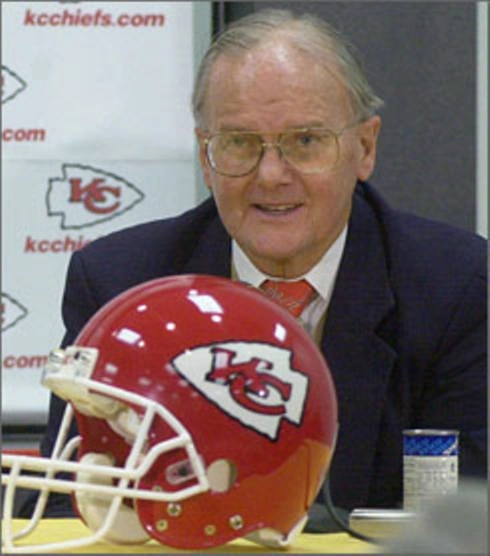
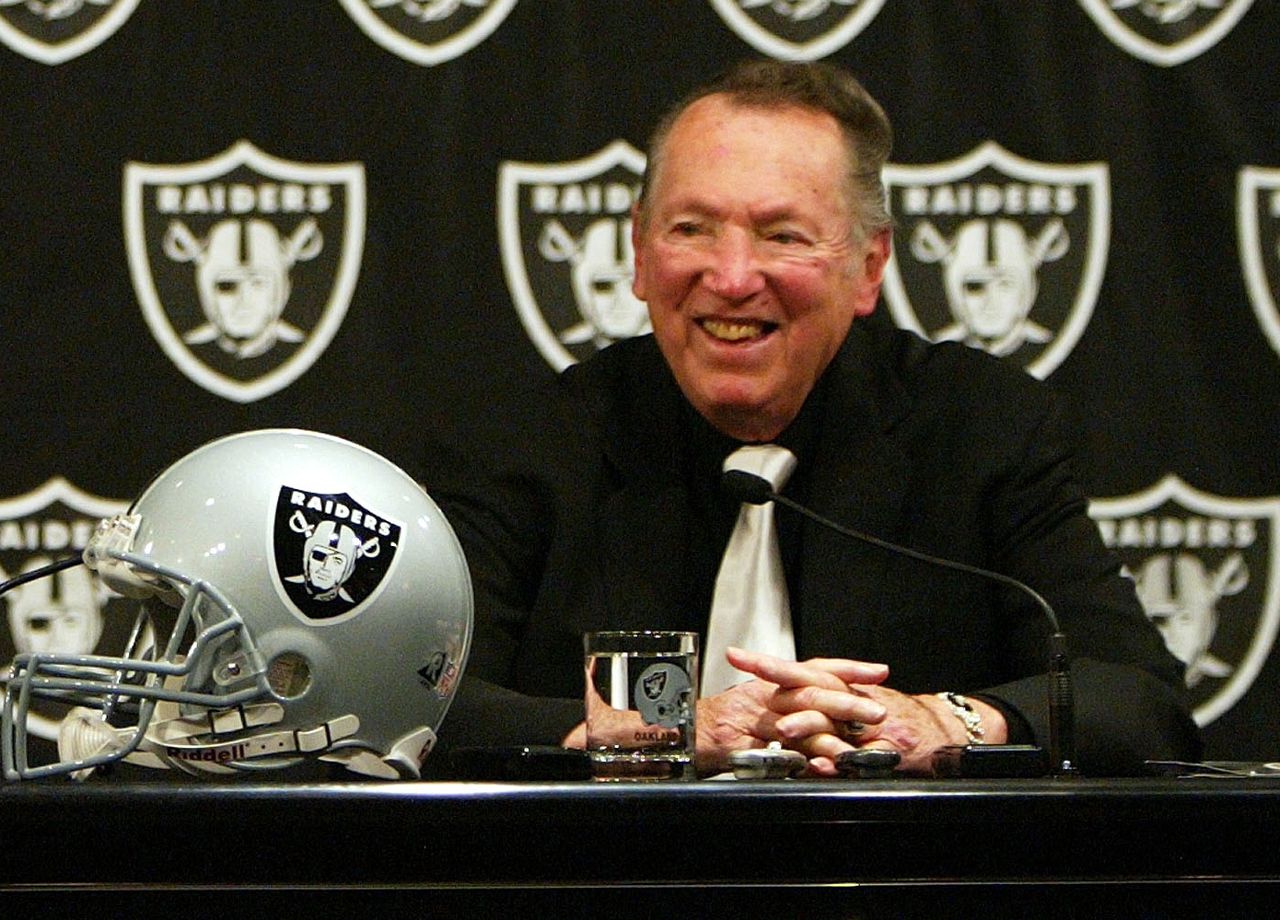



:format(jpeg)/cdn.vox-cdn.com/uploads/chorus_image/image/47622939/paulbrown.0.0.jpg)


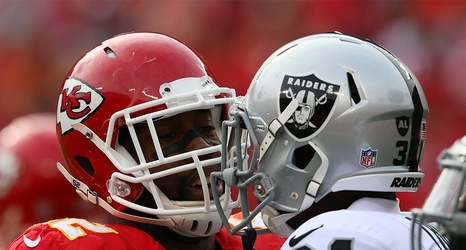

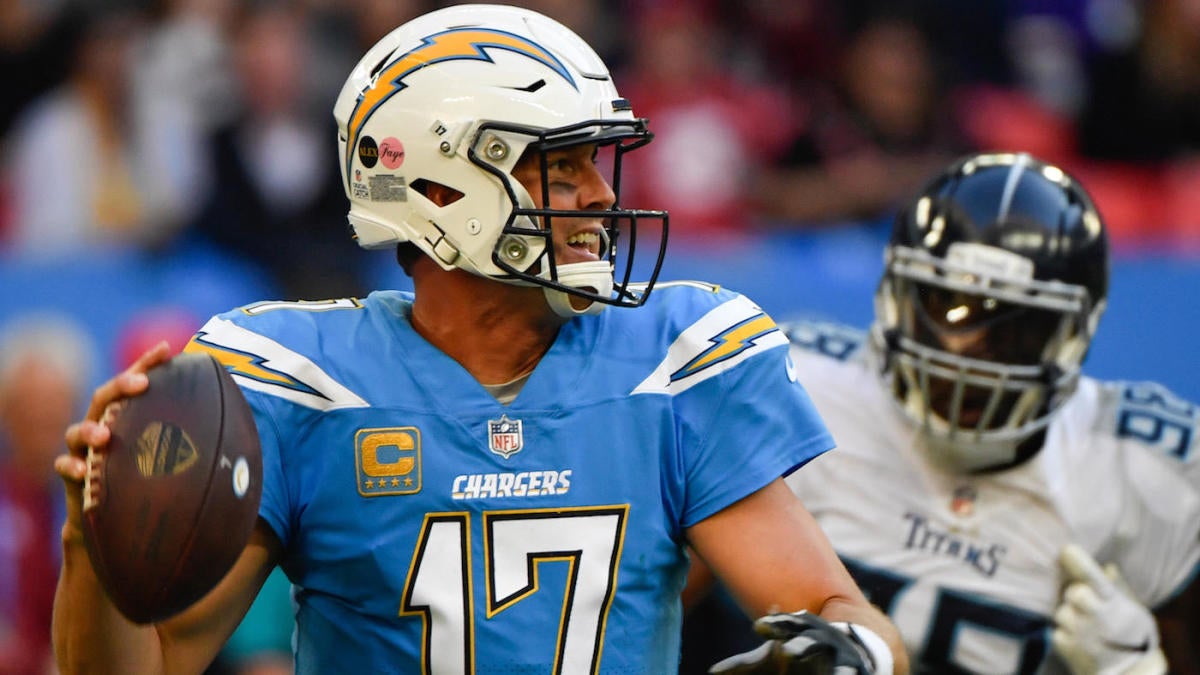
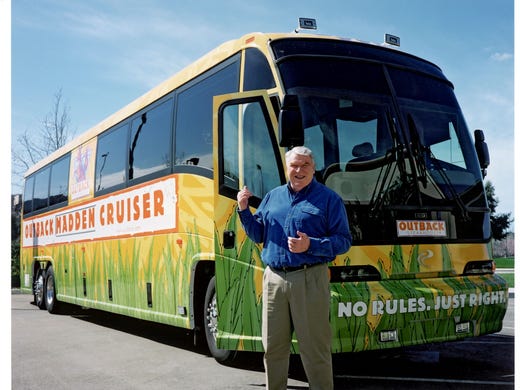
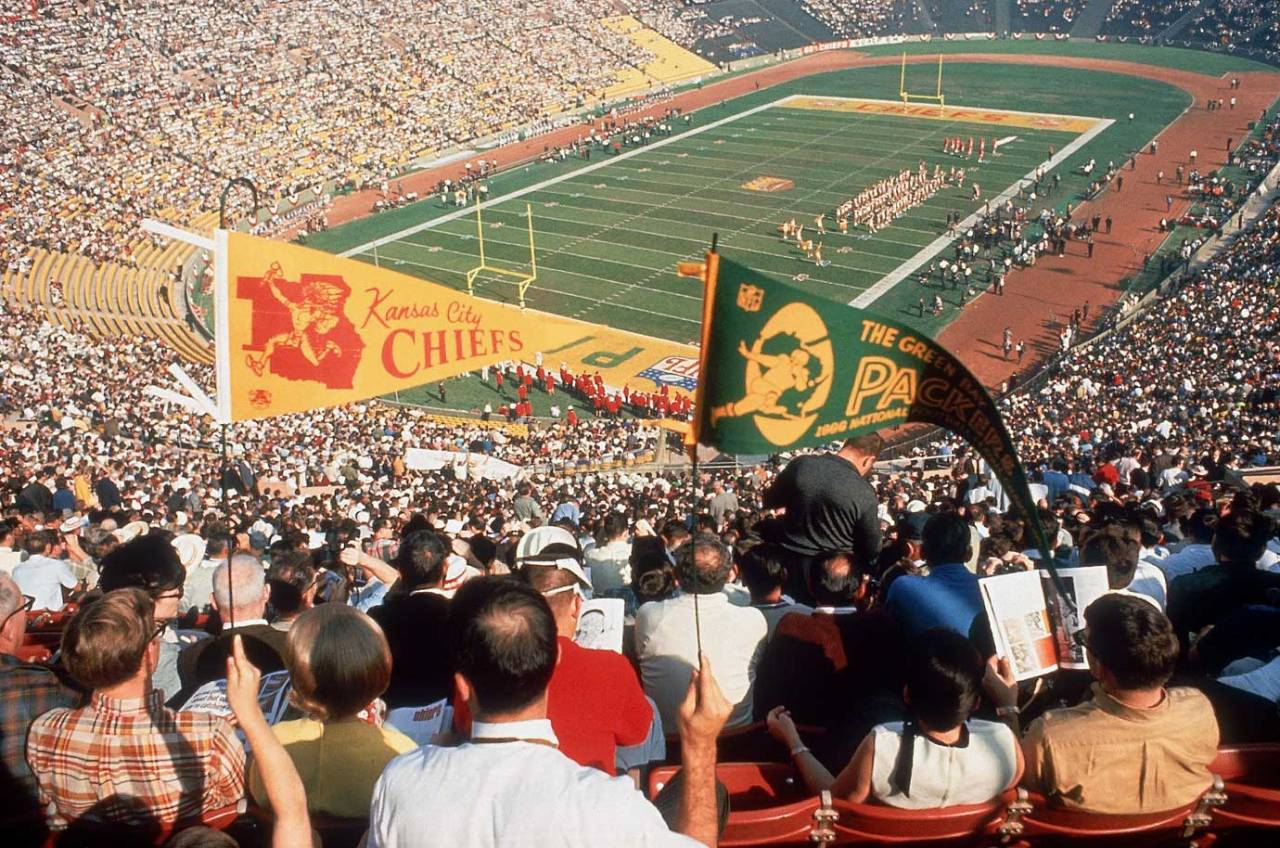

No comments:
Post a Comment